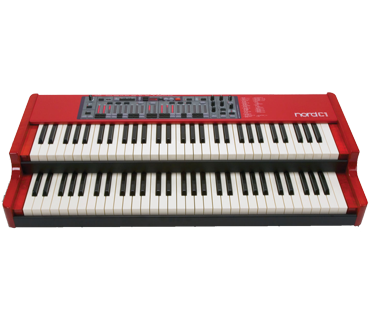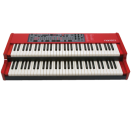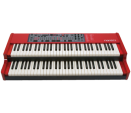Nord C 1
There's no doubt that the tonewheel organ is the godfather of keyboard instruments, and its sound is as relevant and useful now as it has ever been.
Incl. VAT
No longer available
- Fast delivery
- Brick&mortar store in Haarlem
- Come in for a cup of coffee!
- Almost always directly an expert on the line
Product Information Nord C 1
There's no doubt that the tonewheel organ is the godfather of keyboard instruments, and its sound is as relevant and useful now as it has ever been. Bulky, expensive tonewheel organs are yesterday's news, though - today, it's all about the Nord C1.The Nord C1 Combo Organ, a dual-manual clonewheel with all of the massive vintage sound of its tonewheel forebears, with a price and weight that make it accessible to all musicians. At just 33 pounds, the C1 is the most portable digital organ ever. What makes classic tonewheel organs sound the way they do is a complex set of electromechanical interactions - metal discs rotate beneath magnetic pickups to produce the fundamental sound, and mechanical drawbar positions regulate the volume of component waveforms. Instead of merely imitating the result of these interactions, Clavia has used advanced modeling technology to emulate the individual components of the tonewheel organ, making the resulting sound more authentic than any other clonewheel in the world.
The C1, though, isn't just a tonewheel clone. Included on the instrument are two transistor organ models. In the 1950s, 60s, an 70s, transistor organs provided an alternative to tonewheel organs, and their sound was just as popular. Transistor organ parts made songs like "96 Tears" and "House of the Rising Sun" hits. The C1 includes two of the most popular transistor organs from that era - based on the Vox™ Continental and Farfisa™ Compact Deluxe - both as faithfully emulated as the C1's tonewheel model.
The C1's rotary speaker is as faithful a representation of rotary speakers as the tonewheel organ is. Activated in the speaker sim section on the right side of the panel, the rotary sim will speed up, slow down, or stop the virtual rotation of upper and ower horns.
With the use of the optional Half-Moon Switch, the rotary controls on the panel can be bypassed. That same bypass can be assigned to a momentary ("square-style") pedal as well.
Have your own rotary speaker? No problem - thte C1 includes an 11-pin output so it can be connected directly to the rotary speaker of your choice (an adapter my be required). Doing so transfers all rotary controls to the actual speaker, bypassing the rotary speaker sim. Dizzy yet?
The C1 features many analog-style effects to boost your organ performance into any realm imaginable . Unison is a special kind of chorus, fattening up the output signal without phasing. Speaker simulations include the rotary speaker, a Fender™ Twin Reverb model (Amp1), and a Roland™ Jazz Chorus model (Amp2). The C1 also includes a 5 algorithm reverb, and a 3-band EQ. A delay with tap-tempo is provided, as well as a tube-style overdrive that will make you C1 sound like it's on fire.
The Bass Module controls the bass pedal sounds. When a pedal controller is connected to the dedicated bass pedal MIDI iput, the pedals control the bass sound. Without bass pedals, the bass sound can be played from the bottom two octaves of the lower manual. You can play an organ bass, or use a bass synth sound.
There's no doubt that the tonewheel organ is the godfather of keyboard instruments, and its sound is as relevant and useful now as it has ever been.
Heb jij de
Nord C 1
Elders goedkoper gezien?!
Laat het ons weten en we doen een voorstel
Reviews
Among all the entrants of a review we raffle a voucher every month of 25 euro! Write a review






